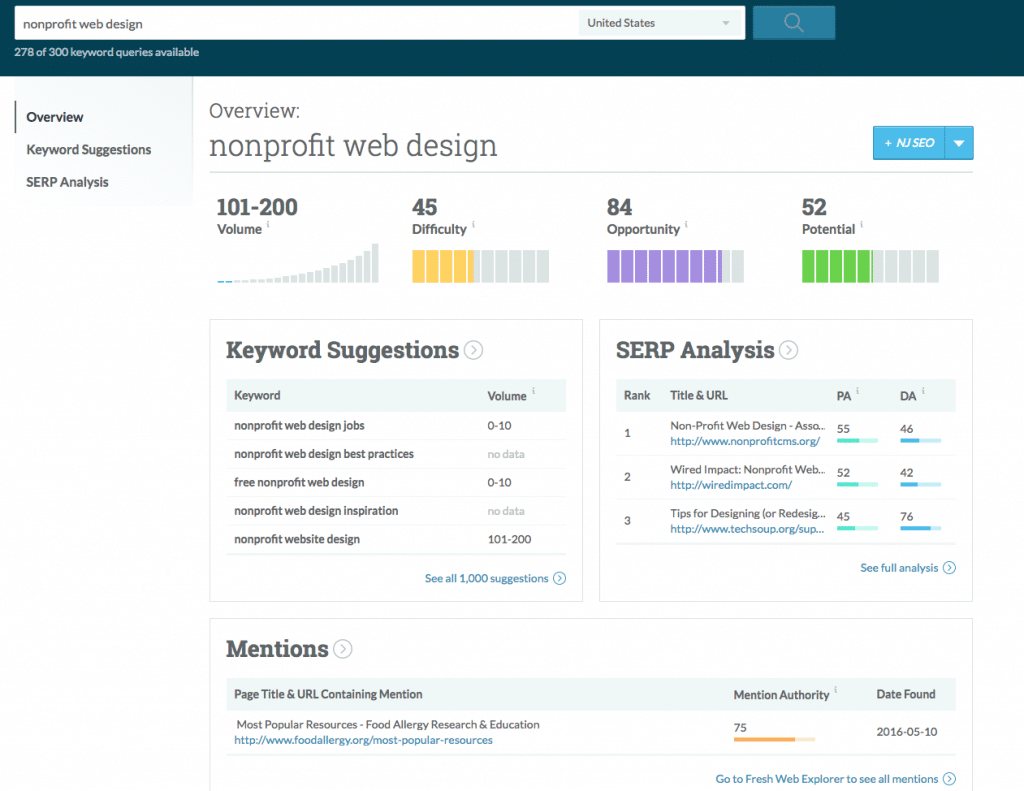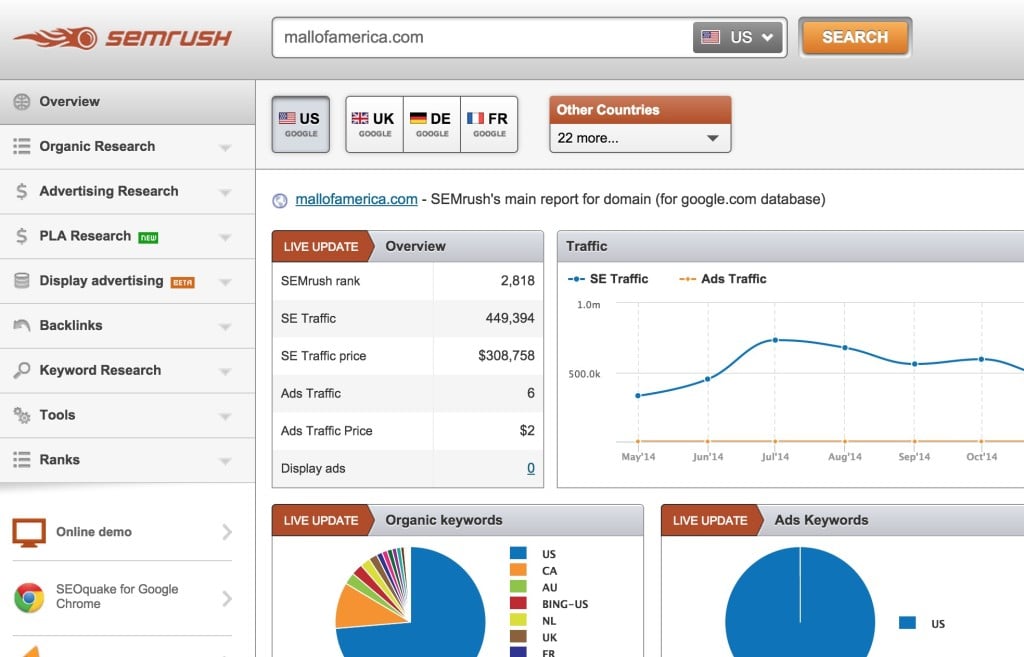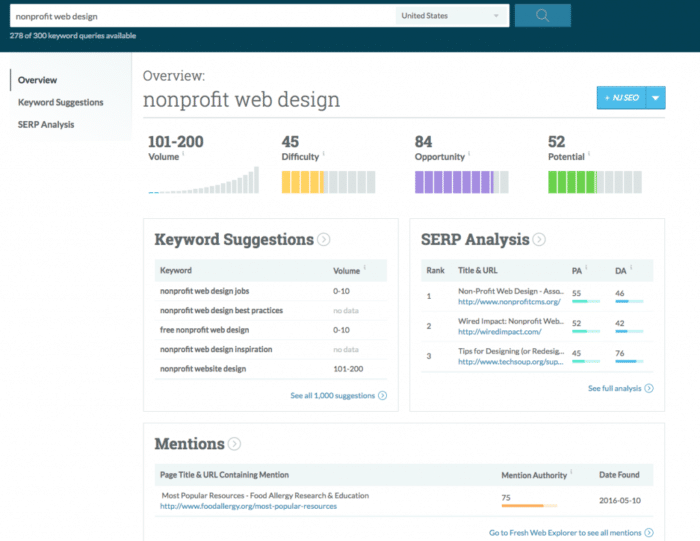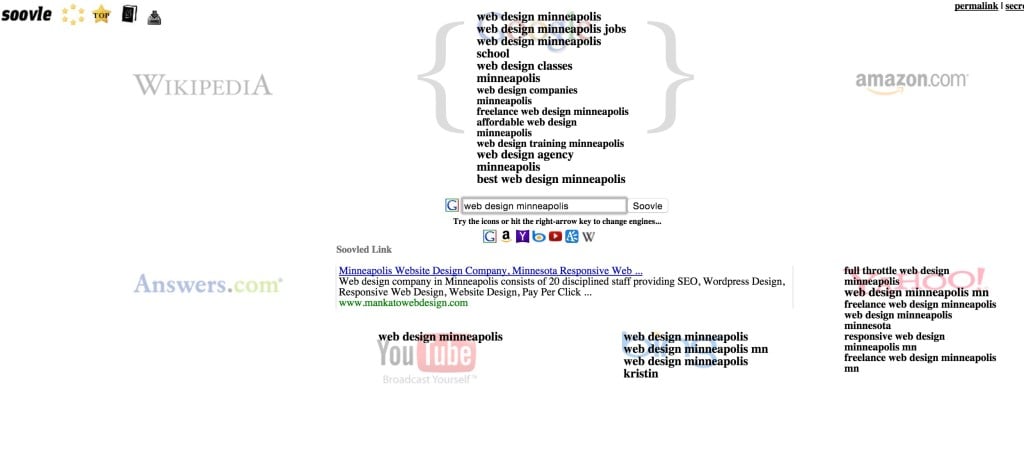Given below are some of the best keyword research tools recommended for laying a well-rounded keyword foundation for SEO and also include keyword research tools, keyword finders, and highly profitable keyword research tools:
1. KWFinder
KWFinder is a highly effective long tail keyword research tool and has a really great interface. It displays search volumes, trends, CPC, and level even the difficulty in results. Once a user clicks on a particular keyword, a second window will pop up displaying the respective difficulty level ranging from one to hundred, along with the current Google search results.
This shows users what existing domains in the market are targeting the keyword, along with social shares, the page’s backlinks, and the traffic. Such extra dimensions of the keyword can be relevant, even more so, while integrating SEO with content marketing. Also this tool aids in the task of local keyword research helping users to target the search results based on the city, country or state.
2. Keyword XP Pro
Keyword XP Pro is the keyword research software that has almost all of the tools you need in your one dream application.
Check what Keyword XP Pro brings to the table…
- helps you find available domains and even create branded domain names for you
- provides you with more than 800 variations of a seed keyword
- shows cost per click [CPC] and advertiser competition
- finds backlinking opportunities to rank faster in SERPS
- show types of questions that people are searching for
- detailed competitor analysis
- viral blog title generator
- related questions expansion
- trend reporting
- and much more…

3. Moz’s Keyword Explorer
This is a brand new tool which piles on a few bonus features when it comes to keyword research. Along with Keyword Volume and Difficulty, there is also included – Opportunity which is defined as the relative CTR of organic results on Search Engine Rankings Pages. Also given will be the importance, which denotes the criticality a Keyword represents to a campaign. Finally, the Potential refers to the combination of every keyword metric that exists to help users prioritize.
This tool functions based on other smaller tools such as Google Suggest, Keyword Planner, and even related searches. Users, who have developed keyword lists prior, can quite easily upload such lists to the Keyword Explorer to gain higher insights and prioritize. The Keyword Planner also provides a much greater understanding if why particular pages rank the way they do on social data and based on link as well. This helps greatly in users planning their SEO strategies well beyond keyword research.
4. Keyword Tool
Keyword Tool is a great place to start with regard to keyword data mining. This tool utilizes Google Autocomplete data to generate its detailed database of long tail keyword suggestions.
Most users utilizing Google Keyword planner for the purposes of Keyword research should also implement Keyword Tool. This tool is mostly architected for advertisers; therefore it usually never shows highly lucrative long-tail keywords that most Keyword Tools capture.
This tool is based on a freemium model giving out the first 750+ keyword suggestions post which one has to sign up for the professional version to view data like CPC on AdWords, search volume, and more. It also enables one to export results to CSV format. A brilliant feature of this is that it helps users to find long tail keywords for YouTube, Bing, App Store and more.
5. Google Keyword Planner
Google Keyword Planner is the most useful tool for keyword research that can make any web content SEO optimized.
Even though it has been designed for advertising, individuals can use it to research organic keywords by tailoring the results for any competitor. All one has to do is enter the target product or service, the competing organization’s landing page and even the product category. The search can then be customized and tailored for specific keywords.
With the Google Keyword Planner one can cross-match keyword lists to generate new keyword ideas, Retrieve traffic forecasts for a specified list of keywords, obtain search volume for a list of keywords or group them into ad groups and even search for new keyword and ad group ideas.
An individual should focus on ad group ideas as well as keyword ideas, as both can aid quite a bit when it comes to SEO. Ad group ideas consist of a group of related keywords that usually won’t show up in generic keyword ideas.
Users can monitor metrics such as average monthly searches, competition, and more to decide on relevant keywords to target for better results. If you plan on doing SEO and PPC together, Keyword Planner can help you determine which keywords are better to target organically or with advertising. One can also implement Keyword Planner’s suggestions as a foundation to build on long tail keywords with the other tools.
6. Long Tail Pro (Premium)
This tool is based on the assumption that LTP (Long Tail Pro) helps users locate keywords which are impossible to be found using Google keyword Planner. It is a tool which works as an extension to Google Adwords account to enable it to find the best keywords possible. One can then start a new project to locate new long tail keywords holding a certain number of words. One can use range of searches for every month an even localization options such as country and state.
One of the hardest things to try and do with keyword analysis is to uncover connected keywords. Although my expertise revolves around being a WordPress Specialist in Minneapolis, I keep an eye on things like Keyword research, Search engine optimization, Search Engine Marketing and Paid Search. With that in mind, these are reviews for tools that all will help you establish connected keywords that you perhaps you might want to look into a little more.

These tools aren’t a substitute for elaborated keyword analysis done by someone with an expertise related to keywords. Rather, the tools reviewed here will help you get in the right direction to either establish those keywords that are most significant to your you and your competitors, or facilitate obscure opportunities wherever there is very little search volume; but also there’s not very much competition. This is the key to wielding keywords effectively. Most of the tools here are free, though they may have paid options.
1. KEYWORDEYE
Because this was created in the UK, you’ll need to change the option to Google U.S.A. It works by pulling information from the Google keyword API. Enter your keywords, and creates a tag cloud showing these items and shows the most search keywords larger in that cloud. Based on can quickly see what people are searching for. Perhaps if you’re into Google’s Keyword Tool, you might be noting that you can simply sort by search volume. The other key difference for Keyword Eye is that it helps you quickly visualize what items have a crazy amount of competition by having those items show in red, or Green for lower competition.
Why does it matter to you? This way you can quickly determine the low hanging fruit keywords and target them accordingly. Increasing your ability to target your content for SEO, SEM, or Paid Search. Thus, you can increase your return on investment in these endeavors and be a hero!
The free version of this tool will limit you to only a hundred keywords, sp it’s helpful for prime level concepts, but it’s not an in-depth keyword analysis substitute.
Here’s a screen shot of how “backpacks” shows up in Google Delaware ordered by Adwords competition low on the bottom to high on the top:

As you can see, this can be a simple, thanks to bringing to the surface plenty of connected keywords that don’t essentially contain the word “backpack”.
2. KeywordSpy
With KeywordSpy you get many different keywords for different industries, so you get a good cross-section. In terms of real world application that you can use right now, the Keyword Spy add on has got to be the best feature. You can download the add-on for chrome, and basically it allows you to open up a domain report on any website for your competitors.
Keyword Spy allows you to quite literally “spy” on keywords. It’s a very appropriate name for the tool. There are several key features of the free version of this tool, but the one that might be the most useful off the bat is the Domain spying tool. Just type any domain into the search box, have the radio button for “domains” is selected, and you can get pretty accurate data on how much that site might be spending in paid search, who their competitors are in particular, and what keywords they spend the largest amount on, and more:
Those tabs across the top work too, and while with a free trial, you can only get 10-20 results in each tab, the information is still really useful. The “Ads” page for example shows you Geico’s top ad copies with some key information about those ads. You can even click on the little “KW” button to get more keywords that are in that specific ad group:
Plus, you can export any of this info into Excel, CSV, or Google Spreadsheets. Also, you it has Export capability for free when this feature is usually not offered with free products.
Drawbacks to this tool: For less searched for queries or sites, it may have absolutely no info whatsoever. It’s related searches can be pretty erroneous occasionally. I’d say it’s still a worthwhile tool to play for a little bit, and perhaps use for bigger accounts.
The competitors tab in this tool is also pretty neat; you can see both organic and paid competitors side by side. The Top Lists page is mostly just info to know with no direct application, but one of these lists is the keywords with the largest cost per click change. This information, which is not always readily available in other tools, can be quite useful in detecting upcoming trends as they are upcoming.
3. SEMRush
This tool is additionally a paid tool with a free choice, however not like alternative free choices, this tool provides simply enough knowledge in its free application to be helpful. One feature that SEMRush has that you may not find elsewhere is the metric for the amount of leads to Google.
The number of results is helpful as a result of it basically shows you the way massive the competitive field is for a keyword. rather than showing you simply the amount of competitors, or who desires to purchase it and how abundant, it shows you that there are perhaps a hundred forty five million alternative pages that use this term in a very manner that Google feels could also be relevant. So a lot of these tools basically help you understand search queries and amount of competition in different ways.

Another situational context piece that SEMRush provides, and one thing you might not see all over else is “related keywords”.
Staying with the instance of “backpack”, you’ll see below that SEMRush points out a handful of vital keywords that don’t seem to be relevant to a website merchandising baggage that you simply carry stuff in and sling over your shoulders. These keywords all confer with associate degree application named “backpack” that was created by 37Signals and could be a companion to BaseCamp that could be a project management system.
This is a crucial piece of knowledge, and something i would like to create positive I place within the negatives of my PPC campaign. Sure, i might realize it eventually anyway if I’m optimizing my account well; however this manner, I don’t need to purchase keywords like this up front.
4. SOOVLE (FREE)
If you’ve got multiple channels you would like to do keyword analysis for and want one where you can very quickly see a visual for, and get some ideas. Soovle seems to be a nice way to do that. From Amazon, WikiPedia, Answers, Youtube, Bing, Google and Yahoo it pulls in related keywords and shows them for you as your typing in the search. So it’s quick, and visual; which I like.
Perhaps you have an idea for an article or a set of ads, and this way you can quickly see that a commonly people are searching for something not quite the same as that, but definitely related. A shift to focus on that slightly related search might yield a ton of results if your competitors are not targeting that for content marketing or paid search strategy.
Soovle is a great keyword research tool to use, but it’s also a great way to brainstorm as you can slowly start typing in your ideas and allow it to auto-generate its own ideas. As another reviewer has said “I would’ve never thought to call a bounce house an inflatable castle, but now I do. 🙂 “
5.Search Term/Query Reports
Now even though you won’t be expanding your keyword net by using search query report mining, you’ll at least be improving your AdWords or Bing Ads account by patching up holes. One common thing to note about many PPC accounts is the lack of attention and detail in which the account owner or previous agency allows one or a few keywords to be the “catch all” for everything. For example if you have the keyword +bounce +house or “bounce house” and that’s the end of it.
The only problem is that you couldn’t really ever laser-target every ad to the search query, and your landing page will definitely not be targeted as it could be. Not even ‘dynamic keyword insertion’ or DKI would help, because who would feel compelled to click on an ad with the simple and boring headline of just “Bounce House”? Let’s just say it gets a bit tricky, and you’re a actually quite lazy if that’s all you do.
Search term/query reports are a PPC report that will show you what search terms have actually triggered your ads based on the current keywords you’re bidding on. So it won’t expand your reach since your ads are already showing for those terms, but it will help you improve quality scores and help you be more specific with the keywords you’re targeting in your account.
I am not an expert in PPC or SEM, but learning about these things help me better wield my expertise in WordPress Web Design in Minneapolis. If you are looking for help with that, let me know. Otherwise, thank you for reading my blog! Share away, if it was useful for you.
Click to Tweet this Article
















